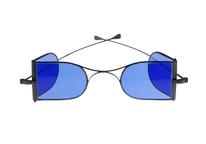

Von Hippel-type clockwork trephine, London, England, 1901-1930
- maker:
- Weiss, John




Von Hippel's automatic trephine, for use in sclerectomy, in leather case, by John Weiss and Son Ltd., London, early 20th century
Trephines are normally associated with cutting out a piece of bone from a skull. However, this clockwork trephine was developed to remove a circular piece from the cornea of an eye, to be transplanted into a patient who was experiencing a disease of the cornea, most likely cataracts. Made by John Weiss, this trephine was invented by Arthur von Hippel (1841-1916), a German surgeon who experimented using both human and animal subjects to perfect his technique.
This trephine forms the prototype for modern day trephines used in eye surgery and von Hippel is acknowledged as the first surgeon to successfully transplant corneal tissue into a human eye.
Details
- Category:
- Ophthalmology
- Collection:
- Sir Henry Wellcome's Museum Collection
- Object Number:
- A617748
- Materials:
- black, red, complete, metal (plated), leather, metal (unknown), felt and silk
- Measurements:
-
overall: 42 mm x 104 mm x 58 mm, 0.14kg
- type:
- trephine




